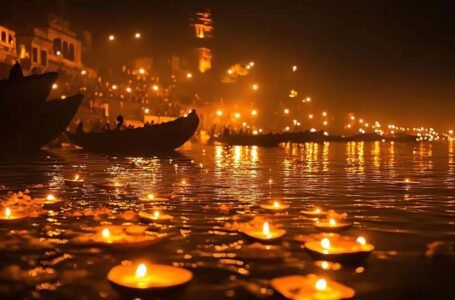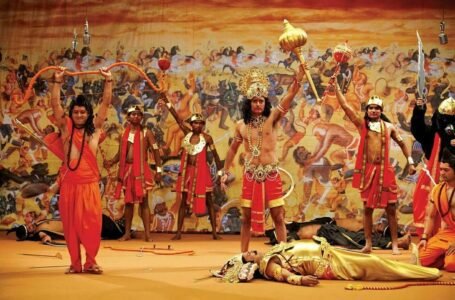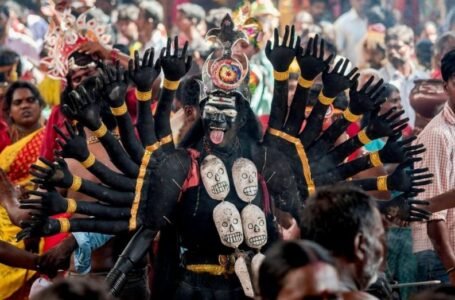The Lost Art of Pandavani: Rest in Pieces: Chhattisgarh and Odisha Folk Lore

India is a country of diverse traditions and when it comes to arts one state or region differs from other because every place of India has its own traditional art forms which originated thousands of years ago. Pandavani is one such form that shot into oblivion and was practiced in the regions of Chhattisgarh and Odisha. Being a synthetic art form of story telling along with singing, Pandavani mirrors the gist of Indian epics particularly the Mahabharata. It is a narrative tradition, which was an important part of cultural activity of the practitioners and the audience and now it has been shifted to the sidelines.

What Exactly is Pandavani?
In simple terms, Pandavani is a style of oral recital of the narratives from the Mahabharata accompanied by singing or singing-dancing drama. But it is not as simple as a spoken language enactment. The fable is presented together with songs which add more emotion and dramatics to the story. The performer preaches the tale and it is known as Pandavani singer to perform whole drama through his voice, being both narrator and singer at same time, creates sound picture for the listener.
The form is normally done singly but may include some accompanying instruments most commonly the dholak or tabla or even the sarangi. Dance instruments are used to set up the rhythm and form a backing music to the singer in relationship to the drama and to the tale being conveyed to an audience.

Pandavani is based on the themes of the great Indian epic the Mahabharata of which account for the Kurukshetra war between the Pandavas and the Kauravas. The story portrays the facets of morality known as dharma, enmity, deceit and practical prowess, and, the essence of man. Furthermore, using the medium of Pandavani, the narrator is not only regaling listeners with these stories but also waking them up with the objective of making it easy to understand for all the age and social classes.
Teejan Bai is regarded as pioneer in Pandavani because of her immense effort in bringing new life in Pandvani and making it famous again. Along with giving a new form to Pandavani the art of storytelling and turning it into a form of performance, she took it to national and international level as she originated from Chhattisgarh. Here’s why she is an important figure:
Revival of the Art Form: It was noticed way back that the unaccompanied solo version of Pandavani, which was the original form, is almost extinct. Teejan Bai performed the format with lot of enthusiasm, giving a modern appeal by narrating and at the same time singing in the format.

Innovative Performance: The class in which Teejan Bai tells a story is characterized by powerful voice and acting out the story. She performed a new form of narration and musical variety dholak harmonium and made it more versatile for the present generation to appreciate.
Global Recognition: She received national and international fame for her style and has taken Pandavani to different prestigious applauded platforms across the globe. Not only has this maintained the traditional nature of getting a car custombuilt for ones personal use; it has gone further in taking the tradition way beyond what it originally used to be in the some civilized Western societies of the world.
Cultural Preservation: Teejan Bai has paid much effort to carry forward the traditional art of Pandavani as well as to educate young people. She has worked hard to keep the art form going in the contemporary society, this means that it has not been left to die.
Empowerment of Women: Teejan Bai proved that women can also perform in such cultural forms and lead such troupes since it is enjoying such reception and success as performed by her. She payed her dues and blazed the trail for women who wanted to become artists.
Teejan Bai has made a rich contribution in developing Pandavani from a folklore of a certain region to an internationally recognised form of art. I have called her the reason behind transformation of Pandavani and its longevity because she is passionate about it, she innovated it out of tradition and dedicated herself to the cause.

The Social importance and Relevance of Pandavani
Traditionally, Pandavani has been performed equally as entertainment, education and preservation of culture in rural and tribes of Chhattisgarh and Odisha. Specifically as a storytelling tradition, it was an inevitable practice to pass on many cultural values and also teach people good moral values. Long before even contemporary written language and modern technologies came into practice, the art of performing any folklore including the Pandavani was the way through which new generations learned epics.
A unique feature of Pandavani is that it is very emotionally engaging wherein people listening to the perform will likely to have uproarious emotions. When using the natural characteristics of the voice farm, the storyteller is able to switch from one character or emotion to the other effortlessly. A skilled Pandavani performer can give their audience laughter and tears, apart from provoking them into a critical thinking on the issues of right and wrong as depicted in the Mahabharata. Thus, while enjoying Pandavani women were being taught lessons about human behavior and its implications in later life.
Pandavani communicated values with people of the rural and tribal setting who had low levels of literacy and minimum access to formal education. From the ordinary village to the temple or around a fire, these performances established the link between the people to culture and the norm of the society. Originally, the performers were regarded as great narrators; thus, the traditions were entrusted to them, and they had to recall the legends.

The Decline of Pandavani
However, the convention of Pandavani got into some real troubles in the twentieth century as India was modernized and urbanized. One of the important causes of its decline is the emergence of new entertainment types, including the picture theater, radio in the later period and television and World Wide Web in the contemporary period. When the population of cities expanded and the level of education rose, written recensions of the Mahabharata got published, thus the spectators did not have to listen to the epic in form of stories recounted memorized by heart.
Two of the reasons that seem to have affected the decline of Pandavani are the discontinuation of support from the royal families as well as big shots that used to sponsor such performances by the artists. Pandavani performers were traditionally dependent on the support of Kings, landlords and temple officers as they used to call for performances during festivals, on religious occasions, and in the Royal Court. Nevertheless, the degeneration of feudal systems and the weakening of traditional systems for reference, many folk performers lost their sources of income.
This change in lifestyles from rural to urban areas also pulled the plug on anything to do with folk art. The new generation was far from the physical and spiritual affiliations of their forerunners, being more influenced by the Western trend of life and derived forms of entertainment. This resulted in the decline of demand for Pandavani and consequently people skilled in the art started rare.

But one of the most devastating impacts on the practice was the end of the traditional style of singing Pandavani in unaccompanied solo style. Though all the performances are collective in nature and include dancing group and musicians, the Pandavani dance is restricted to only one person now a days. This art form was profoundly rooted to an individual and religious framework of the area; therefore, its deterioration was rather worrisome.
PART ONE REVIVING PANDAVANI To revive means to bring back to life or active practice, but it could also mean to make alive, spirited or joyous The following are the benefits that will be exploited in order to revive pandavani:
It is a misconception to think that attempts at reviving Pandavani as a form of artistic expression, can only have benefits in present day society culturally and socially. Now let’s have a look at the reasons why it would be wise to bring this kind of storytelling back to life.

- Preserving Cultural Heritage
By painting its figurines in the folk art called Pandavani named after the five Pandav royalty brothers, Palette Art carved a niche for itself in Indian tradition of storytelling. This way, we will bring back an art that once was very popular and keep some of our traditions that have been inherited for centuries alive. With globalization and evolution of media, especially digital media, citizens should not abandon the traditional works of art that on one hand give them a sense of place and with one. Pandavani being a societal melodrama means it enshrines in itself a part of the history of a society and thus, when encountered becomes a way of getting acquainted with one’s roots.
- Building a Spiritual Interpretation of Indian Epics
Mahabharata is not just a highly popular historical epic but much more than that. It is a reflection of the challenges of human life experiences. In Pandavani, witness these themes are presented in a manner which invites the audience to experience them firsthand. Hearing it from the great orator is always a thrilling experience and can result into thinking and self reflection especially due to dilemma in virtues, duties and justice. It would help bring back this form of storytelling and encourage people to learn more about these stories now and in the past.

- Part five focused on building community and shared experience
Since all of them are based on social and traditional orientation or theme, Pandavani can still unite the people in a way which is impossible by most so called entertainment industries of today. Another ‘melting pot’ type of impact that one may think will stem from an experience like a listening to the Pandavani performers is that of a common frontier. Some of the productions – such as live, collective performances – become a source of uniting and creating emotionally and spiritually valuable connections in the postmodern world of layoffs and digital isolation.
- Restoration of the lost art of Oral Narration and story telling
Given that today’s generation of people relies on technology and communicates mostly through screens, oral traditions have become limited. When we revive Pandavani the tradition of oral narratives will be revived and the skills learnt include creativity, memory, and public speaking. Thus, performing Pandavani is an art with even your voice ability and skills to play and feel rhythm, emotions and timing into consideration. These are qualities that can be useful also in other spheres of life touchings from interpersonal interactions, business undertakings.
- Promoting Economic Opportunities of Folk Artists
The revival of Pandavani will also create economic benefits to folk artists and performers who have been sidelined for a long time. Thus, creating opportunities for these individuals to perform, the arts can regain the opportunities for earning and acknowledgement. This would go a long way in helping capitalize on the folk art industry in Chhattisgar with Odisha again becoming productive centre for such artists who play an integral role in improving the quality of the society’s arts and culture.

Conclusion
Pandavani is much more about the fate of an art form that thus disappeared and about the value of the epic for our civilization. Pandavani enables the transmission of history and fables through the telling and singing of stories that can corrects moral behavior and foster strong communities today. In this way, reviving this tradition, we can provide ourselves with the valuable signals originated from the previous generations, with the recreational function and consolidation of the public personality identity. Thus, the intent of this project is to build a mechanism to revive the languishing art form of Pandavani—to rekindle the light of the past in the present and forecasted future.


